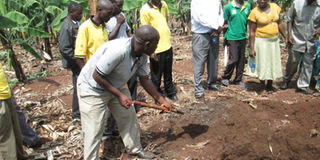Reclaiming the land

Bizuri demonstrates how to dig water retention ditches to other farmers. PHOTOS BY OTUSHABIRE TIBYANGYE
What you need to know:
The situation was so bad that it was almost impossible to find a banana plantation in the village that had not been affected by the disease.
With the bacterial wilt destroying his bananas and soil erosion draining the land of its nutrients, he lost almost everything. John Bizuri tells Otushabire Tibyangye how he was able to recover from the loss.
I am John Bizuri, a resident of Rubagano village, Kigaaga Parish, Mwizi Sub-county in Mbarara District. I am a banana farmer but have had many challenges due to the Banana Bacterial Wilt (BBW) disease, which devastated the area in 2005.
The situation was so bad that it was almost impossible to find a banana plantation in the village that had not been affected by the disease.
I lost three acres and remained with only half an acre. This brought me to my knees, I was producing only small bunches yet I depended on banana for income. There was not even enough food for my family.
Besides the disease, the soils had been depleted of nutrients, and since it is a hilly area, I was also losing the top soil due to poor farming methods.
After losing the banana plantation, I planted coffee, which are now yielding some harvests. I have also used the same piece of land to re-establish a fresh banana plantation.
Turning point
I was a beneficiary of an initiative in which farmers were being trained to mitigate the effects of BBW. One of the methods used was to uproot the affected plants and bury them.
It was an intervention of Kagera Trans-boundary Agro-ecosystem Management Project (Tamp), which focused on improving farmers’ livelihoods through rehabilitation of soils and harnessing water.
Most of the methods taught to us are indigenous and do not require outside intervention other than improvement of the indigenous knowledge.
I have been taught how to improve soil fertility through digging ditches, commonly known as ensania, in our banana plantations for retention of run-off water, which causes soil erosion.
I fill the ditches with banana stem cuttings, green manure, kitchen leftovers, animal dung and any other degradable materials which end up decomposing and providing manure to the bananas.
Within the two years I have implemented this intervention, my plantation has improved tremendously almost bringing me back to the old days.
Currently, I produce about 150 bunches per month and they are very big ones. Around the time, this project started, I had replanted some of the bananas but they were not performing well.
This method has been effective since mine and my neighbours’ plantations have improved tremendously. This has largely succeeded because we share knowledge through farmer field schools and exchange visits to see best practices of other farmers in different locations, where the project is running.
I have also learnt to mulch part of the garden with grass so as to stem off the runoffs and also to keep the soils moist during the dry season.
Another intervention has been to plant Napier grass across the hills to trap the water that would otherwise wash away the top-most fertile soils. I use the Napier grass to feed the goats, whose droppings in turn provide manure for the banana plantations.
Achievements
I have been able to eradicate the BBW disease, re-established my banana plantation to its former state, increased banana yields and diversified my income through coffee and some goats. I have also learnt new methods of farming.
I have improved my homestead because through Kagera Tamp, we were also taught to be healthy through improved hygiene.
I have also learnt to work and share communally. My home has become a centre for learning of the farmer field school in my area.
The proceeds from farming has enabled me to pay for the education of my children in good schools and meet their scholastic requirements.
I hope in two years’ time, my earnings will have doubled. I have also served as a role model to other farmers who come to learn from my gardens.
Challenges
While the methods used in the project area have been successful a lot needs to be done. I fear it may not have an impact on the overall objectives of Kagera Tamp since the intervention is only in two sub-counties.
The lack of animal manure and artificial fertilisers for their crops are still a big challenge to farmers.
Fires have aslo not spared the trees that have been planted. One farmer in Sanga Sub-county lost 40 acres of pine trees, while other trees are destroyed by animals on free range.
I am afraid the interventions may not survive if the district or local authorities do not pick up from where Kagera Tamp has reached in bringing awareness to the local communities since the project is coming to an end.
How to make the ensania
The ditches (ensania) are dug five feet across between banana trees, which are adjacent to each other, to retain water while the banana plants around benefit from the manure.
Dig the ditch round to about 2.5 feet deep. The ditch has to be shallow because bananas have shallow roots, which do not go deeper than that.
Mix the available manure with the top soil, put the mixture into the pit, cut the banana stems into small pieces, put the cuttings into the pit on top of the manure.
Cover the outer part of the pit, leaving the centre open and cover with grass to allow easy sipping of the rain water. For areas which lack animal manure, household-generated garbage acts as a suitable substitute to mix with the top layer. This pit can be used to plant greens like cabbage, tomatoes, dodo, to mention but a few, and retains water for up to three years.




